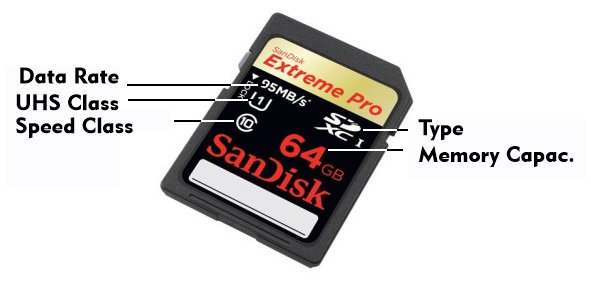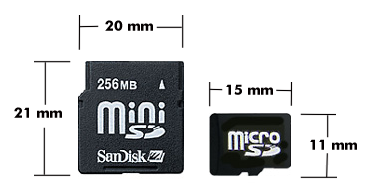secure digital card (SD)
The name Secure Digital Card( SD) is related to Digital Rights Management( DRM), which uses Content Protection for Recordable Media( CPRM). SD cards, whose specifications are drawn up by the Secure Digital Association( SDA), are small memory cards with a built-in controller measuring 24 mm x 32 mm, with a thickness of 2.1 mm.
SD cards are used primarily in digital cameras, but also in MP3 players, video cameras, e-book readers, cell phones and camcorders, as well as PDAs and handhelds. The first Secure Digital cards had a storage capacity of 8 MB, which doubled to 16 MB, 32 MB, etc. in later SD cards. In the meantime, there are SD cards with 512 GB storage capacity.
The write speeds are around 2 MB/s. Speed classes were introduced with the SDHC (High Capacity) and SDXC (Extended Capacity) card versions. The number of the speed class is written on the nameplate in an open circle and corresponds to the write speed in megabytes per second (MB/s). There are the speed classes (Class) 2, 4, 6 and 10. If a 10 is indicated, then the write speed is 10 MB/s. As for the data transfer rate, it is specified as a multiple of the base data rate of 150 KB/s. A Class 6 data transfer rate of 60 MB/s is 400 times the base data rate (x400), and one of 90 MB/s is 600 times (x600).
To increase the data rate, SDHC and SDXC cards are equipped with a faster data bus with Ultra High Speed( UHS). You have to distinguish between the data rates for the UHS bus and those between the SDxx card and the device in these specifications.
The SD card has a serial interface with 9 pins and can be plugged into a PC card adapter and thus connected to the PC card bus. The supply voltage for SD cards is between 2.7 V and 3.6 V. In addition, there are special card readers for flash memory that can handle several formats and can be connected directly to the USB bus.
The different SD card variants
The SD memory card also comes in miniaturized versions as miniSD and microSD cards. With a size of 20 mm x 21 mm, the miniSD card is already considerably smaller than the normal SD card. It is only available in the miniSDHC version and can be operated in an SD card slot with an adapter.
The microSD card measures only 11 mm x 15 mm. Both miniaturized SD cards target the increasing storage needs in smartphones and video cameras and are used for storing digital audio, photos and videos. Both formats are available with storage capacities of several hundred gigabytes (GB).
The SDHC (High Capacity, SD2.0) extends the performance characteristics of the SD card in terms of its storage capacity. The suffix" HC" is used to designate all SD cards with a storage capacity of 4 GB or more. This applies equally to SDHC, miniSDHC and mircoSDHC. The HC specifications extend the performance characteristics for the storage capacity to 32 GB. This makes HC cards suitable for higher performance audio/video and telecommunications devices.
SDXC (Extended Capacity, SD3.0). The XC designation of SDXC stands for Extended Capacity. XC refers to all SDXC cards whose storage capacity is 64 GB or more. This applies to SDXC and also to microSDXC. XC cards can reach storage capacities of 2 terabytes( TB) and more, in practice there are SDXC cards with 256 GB. As file system SDXC uses Extended File Allocation Table( exFAT), which has 64 bitaddress space.


